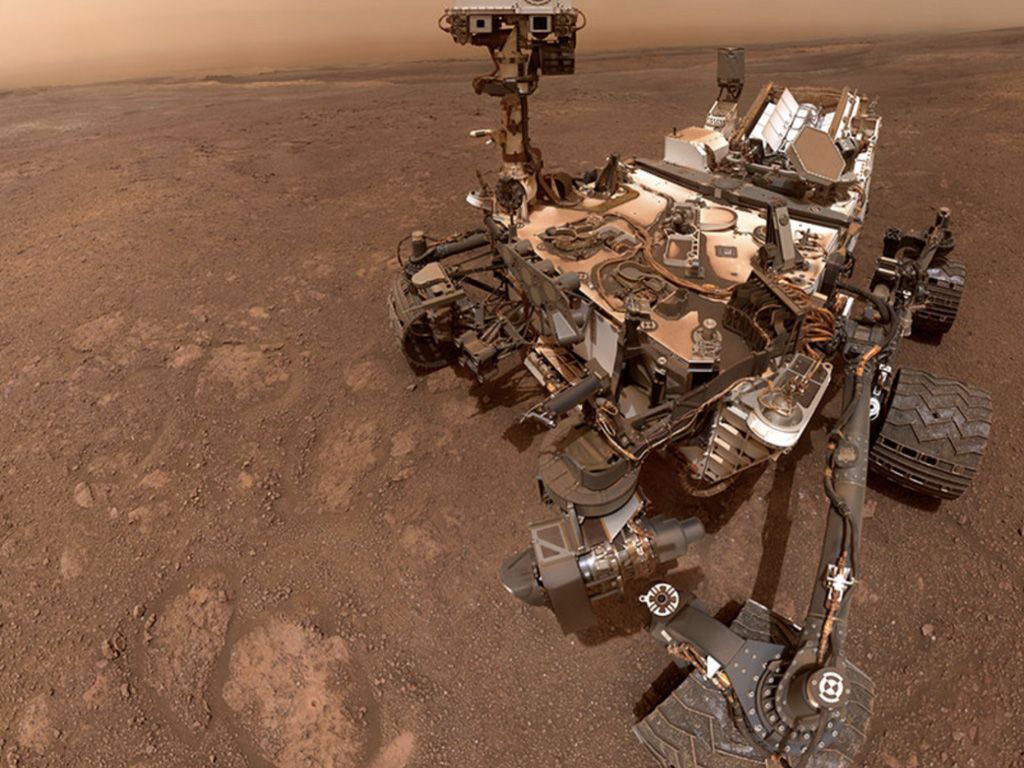A greatly reduced carbon 13 signature is discovered in a drill sample taken by NASA’s Curiosity rover on Vera Rubin Ridge in Gale Crater.

By Beth Johnson
Scientists have been analyzing recent data collected by NASA’s Curiosity rover that has led to headlines everywhere being less than circumspect and a little clickbait-y.
While analyzing samples taken from the Highfield drill hole on Vera Rubin Ridge in Gale Crater, researchers found what they have deemed an “intriguing” carbon signature. They found that the powder in this sample was strongly depleted in carbon 13, one of two stable carbon isotopes. Here on Earth, depletion of this sort can be caused by the ultraviolet degradation of biological methane.
Take a moment to giggle over cow farts, and then let’s move on.
How do we know the sample is reduced in this particular isotope? Christopher H. House, lead author of the new paper in the Proceedings of the National Academy of Sciences, explains: The amounts of carbon 12 and carbon 13 in our solar system are the amounts that existed at the formation of the solar system. Both exist in everything, but because carbon 12 reacts more quickly than carbon 13, looking at the relative amounts of each in samples can reveal the carbon cycle.
So Curiosity samples a rock by drilling into its surface. Then another instrument heats that sample to separate out various chemicals. Finally, the sample is analyzed spectrographically, and the spectra tell us what was actually in the sample, including the relative proportions of different isotopes. They compare those proportions with what is already known to exist in our solar system, and voila, carbon 13 is relatively absent.

Now, about those headlines. Yes, on Earth, we see a depletion of carbon 13 due to the breakdown of biogenic methane, whose composition is CH4 — one carbon to four hydrogen. The methane is broken down, and the carbon escapes into the atmosphere. However, there are two other possibilities for this process: a cosmic dust cloud or that same ultraviolet breakdown but of carbon dioxide instead of methane. And carbon dioxide can easily come from volcanic activity on Mars, which definitely would not mean life.
No counting Martian chickens before you find eggshells or skeletons.
I want to back up just a moment and explain just how a cosmic dust cloud could be involved because it’s an interesting point in the press release that is getting overlooked in the media. Per the release: To create a layer that Curiosity could sample, the galactic dust cloud would have first lowered the temperature on a Mars that still contained water and created glaciers. The dust would have deposited on top of the ice and would then need to remain in place once the glacier melted, leaving behind a layer of dirt that included the carbon.
But we have limited evidence for past glaciers on Mars, particularly in Gale Crater, so while the explanation is plausible, more evidence is required to back that particular possibility up.
And while Mars has definitely had active volcanoes in the past, and may even have underground magma chambers currently, it’s also possible that any past methane may have an abiogenic source, since Mars is not Earth, and the two planets are very different. Regardless, this newly discovered carbon signature points to the possibility of an unusual carbon cycle on Mars, but more data is needed to confirm the signature and pinpoint the cause.
That doesn’t mean it wasn’t life. I don’t want to completely quash anyone’s hopes in that respect. Microbial mats are still very much a possibility. We need to take more samples and keep looking around Gale Crater, and we definitely need Percy to keep looking over in Jezero crater as well.
After all, life, uh, finds a way, right?
More Information
NASA Goddard press release
Penn State press release
“Depleted carbon isotope compositions observed at Gale crater, Mars,” Christopher H. House et al., 2022 January 25, PNAS
This story was written for the Daily Space podcast/YouTube series. Want more news from myself, Dr. Pamela Gay, and Erik Madaus? Check out DailySpace.org.
This article was originally posted on medium.com.





